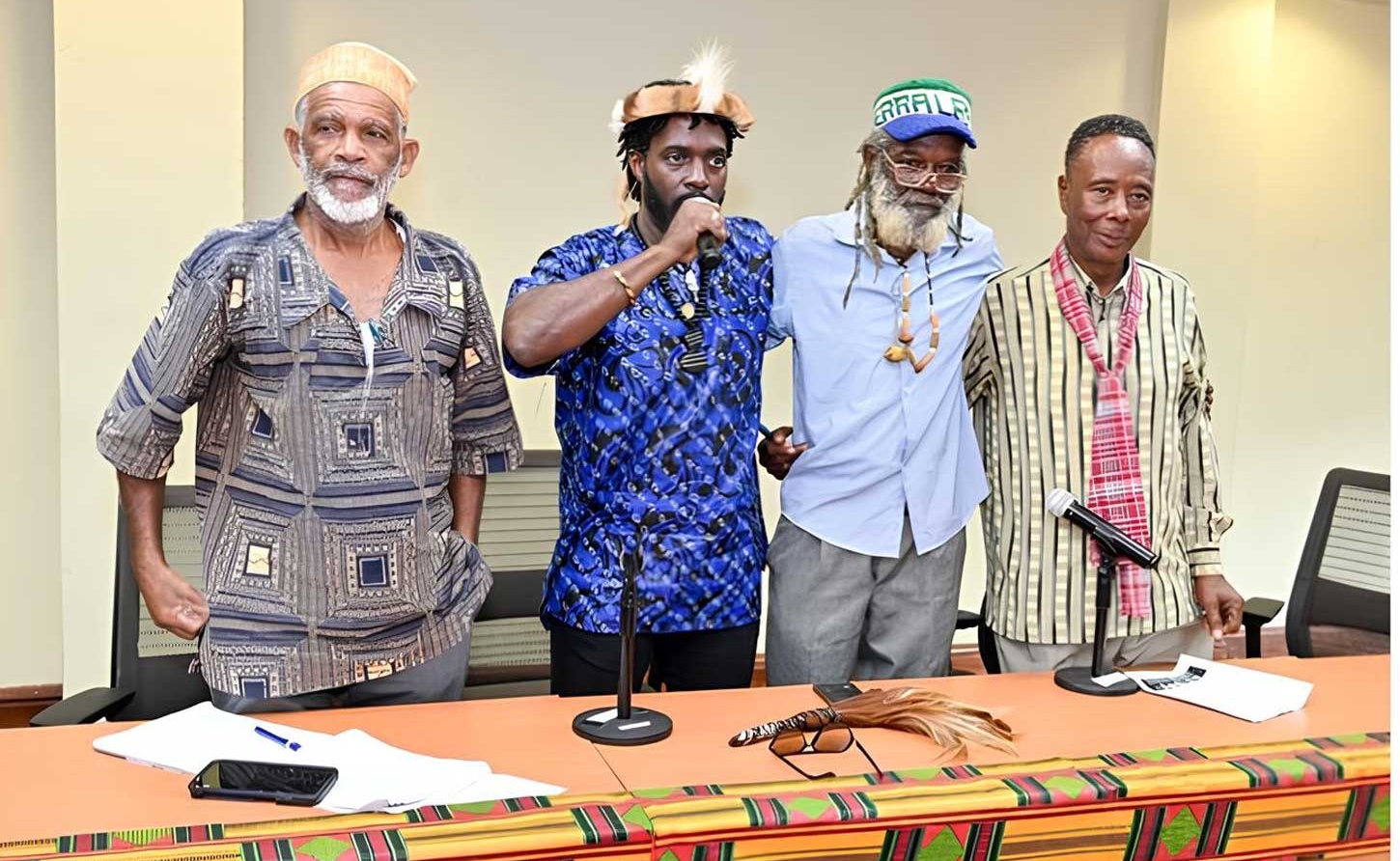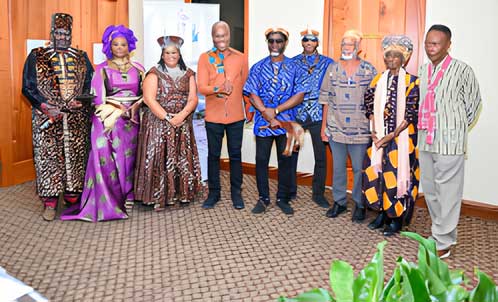JAMAICA | Maroon Leaders Challenge Historical Misconceptions at Landmark Symposium

Kingston, Jamaica – February 14, 2025 – The Maroon Chiefs of Accompong, Moore Town, and Scotts Hall have pushed back against long-standing misconceptions about their history, asserting their role as fierce resistance fighters rather than passive recipients of freedom.
Speaking at the symposium The Maroons of Jamaica: “Our Legacies, Telling Our Own Truths”, held on January 9, 2025, at The University of the West Indies (UWI) Regional Headquarters, the leaders directly addressed myths surrounding the 1739 Treaty with the British and the Maroons' legacy in Jamaica’s fight for self-determination.
The Treaty, gave enslaved individuals the choice to either remain with the Maroons under the leadership of Captain Cudjoe or return to their enslavers with a guarantee of pardon and indemnity. “
Organized by the CARICOM Reparations Commission in collaboration with the UWI Centre for Reparation Research and Maroon communities, the event served as a platform for Maroon leaders, scholars, and cultural ambassadors to reclaim their narrative. They highlighted the Maroons’ military expertise, territorial knowledge, and diplomatic acumen that forced the British into negotiations.
The symposium also confronted controversial interpretations of the Treaty, particularly regarding the return of runaway enslaved people, which Maroon leaders argued was a distortion used to divide Black communities.
The Maroons’ Legacy of Resistance and the 1739 Treaty
The Maroons of Jamaica have long been regarded as formidable warriors who defied colonial rule, using their deep knowledge of the island’s rugged terrain to wage relentless guerrilla warfare against European forces. Their resistance dates back to the late 17th century when groups of formerly enslaved Africans escaped into the mountains and formed autonomous settlements.
For decades, they launched strategic attacks on British plantations, disrupting the colony’s economy and undermining the institution of slavery.
One of the central discussions at the symposium was the significance of the 1739 Treaty between the Maroons and the British Crown. Chief Richard Currie of Accompong described the agreement as “the most powerful ever signed by the British with any indigenous entity,” emphasizing that it was secured through military strength rather than British benevolence.

Despite these debates, symposium speakers underscored the treaty’s broader impact. Attorney Bert Samuels challenged the notion that the Maroons were simply granted 1,500 acres by the British, arguing that under the legal principle of adverse possession, they had already claimed the land through continuous occupation.
Maroon leaders further asserted that the treaty laid the groundwork for emancipation by proving that freedom could be won through resistance and self-determination.
Debunking Myths and Reclaiming the Maroon Narrative
A key focus of the symposium was challenging the narrative that the Maroons were complicit in returning runaway enslaved people to British authorities. Ambassador Anu El of Accompong directly addressed this misconception, highlighting how colonial powers weaponized division to weaken African resistance.
“ Chief Richard Currie of Accompong described the agreement as “the most powerful ever signed by the British with any indigenous entity,” emphasizing that it was secured through military strength rather than British benevolence. ”
He pointed to Clauses 2 and 6 of the Treaty, which he argued gave enslaved individuals the choice to either remain with the Maroons under the leadership of Captain Cudjoe or return to their enslavers with a guarantee of pardon and indemnity. “The treaty granted individuals a choice,” he stated. “Those who chose to return were guaranteed safety and protection by the Maroons.”
Legal experts at the symposium, including attorney Bert Samuels, called for further research into whether the treaty’s more contentious clauses—such as Clause 9, which called for the return of all “negroes” taken after the signing—were ever strictly enforced.
Samuels questioned whether there was concrete evidence of the Maroons actively capturing and returning runaways, arguing that colonial accounts often served to vilify the Maroons and diminish their role as freedom fighters.
Colonel Lattibeaudiere of Scotts Hall further emphasized that the treaty was heavily skewed in favor of the British, detailing how it outlined clear expectations for the Maroons while placing little obligation on the colonial authorities.
Colonel Wallace Sterling added that what was ultimately documented in the treaty may not have fully reflected the original negotiations, as final approval rested with the British government in London. This, he suggested, contributed to deep-seated mistrust between the Maroons and the British in the years that followed.
Maroon Resistance Beyond the Treaty

“The Maroons’ resistance hit the British where it hurt most—in their pockets,” he stated, reinforcing the view that their actions directly contributed to the eventual abolition of slavery.
He also addressed the historical controversy linking the Maroons to the suppression of the Morant Bay Rebellion of 1865, in which colonial authorities called upon Maroon forces to help quell the uprising led by Paul Bogle and George William Gordon.
Chief Currie argued that such claims were part of a long-standing effort to discredit the Maroons and justify attempts to revoke their treaty rights. “They blamed the Paul Bogle rebellion on Accompong, and look how far away Accompong is from St. Thomas,” he said, pointing to the geographical and historical inconsistencies in this narrative.
The symposium underscored that while the Maroons negotiated peace with the British, they never abandoned their militant stance. Many continued to support resistance movements, both directly and indirectly, ensuring that their legacy remained one of defiance rather than submission.
Forging a Path Forward: Calls for Education and Unity
One of the major outcomes of the symposium was a proposal to establish an Institute of Maroon and Indigenous Studies at the University of the West Indies and within Maroon communities.
The institute would focus on historical research, cultural preservation, and addressing long-standing misinterpretations of Maroon history. Scholars and community leaders expressed a need for greater education on the Maroons' role in Jamaica’s freedom struggle, both within Jamaica and across the African diaspora.
Chief Currie closed the event with a powerful call for unity and historical recognition. “The Maroons’ story is one of triumph, sacrifice, and an unyielding commitment to freedom,” he said. “It is time we honor that legacy and ensure that future generations understand the true history of Jamaica’s first freedom fighters.”
“ In an effort to link the Maroons to the suppression of the Morant Bay Rebellion of 1865 and justify attempts to revoke their treaty rights. The British blamed the Paul Bogle rebellion on Accompong, and look how far away Accompong is from St. Thomas! ”
Ambassador Anu El reinforced this sentiment, reminding attendees that the Maroons' treaties predate the establishment of the Jamaican government and remain recognized under international law. “Our rights must be respected,” he asserted.
The symposium marked a pivotal moment in the ongoing effort to reclaim the Maroon narrative, bringing together leaders, scholars, and cultural ambassadors in a collective mission to correct the historical record.
As discussions continue, the Maroons remain steadfast in their demand for recognition—not as traitors or colonial allies, but as the vanguard of Jamaica’s long and complex fight for freedom.
Rewriting History on Maroon Terms
The symposium The Maroons of Jamaica: “Our Legacies, Telling Our Own Truths” marked a significant moment in the ongoing reexamination of Maroon history. By directly confronting longstanding myths and colonial distortions, Maroon leaders and scholars reaffirmed the Maroons’ place as pioneers of resistance and self-determination.
The discussions not only shed light on the complexities of the 1739 Treaty but also underscored the need for continued research and education to ensure that the Maroons’ true legacy is preserved.
With plans for the establishment of an Institute of Maroon and Indigenous Studies and renewed calls for unity among Maroon communities, the event signaled a broader movement toward reclaiming historical narratives from a Maroon perspective.
As Chief Richard Currie and other leaders emphasized, the Maroons’ story is one of strength, defiance, and an unbroken commitment to freedom—one that must be told with accuracy and pride.
As Jamaica and the wider African diaspora continue to explore the legacies of colonialism and resistance, the Maroons stand as a testament to the power of self-determination. Their history is not one of betrayal or submission but of resilience, strategic warfare, and an unyielding fight for autonomy.
With this symposium, the Maroons have taken another step in ensuring that their truths are no longer told by others but by their own voices, for future generations to hear and understand.
-30-

 En
En  Ar
Ar